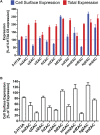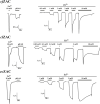Evolutionary conservation of Zinc-Activated Channel (ZAC) functionality in mammals: a range of mammalian ZACs assemble into cell surface-expressed functional receptors
- PMID: 37745686
- PMCID: PMC10513076
- DOI: 10.3389/fmolb.2023.1265429
Evolutionary conservation of Zinc-Activated Channel (ZAC) functionality in mammals: a range of mammalian ZACs assemble into cell surface-expressed functional receptors
Abstract
In contrast to the other pentameric ligand-gated ion channels in the Cys-loop receptor superfamily, the ZACN gene encoding for the Zinc-Activated Channel (ZAC) is exclusively found in the mammalian genome. Human ZAC assembles into homomeric cation-selective channels gated by Zn2+, Cu2+ and H+, but the function of the receptor in human physiology is presently poorly understood. In this study, the degree of evolutionary conservation of a functional ZAC in mammals was probed by investigating the abilities of a selection of ZACs from 10 other mammalian species than human to be expressed at the protein level and assemble into cell surface-expressed functional receptors in mammalian cells and in Xenopus oocytes. In an enzyme-linked immunosorbent assay, transient transfections of tsA201 cells with cDNAs of hemagglutinin (HA)-epitope-tagged versions of these 10 ZACs resulted in robust total expression and cell surface expression levels of all proteins. Moreover, injection of cRNAs for 6 of these ZACs in oocytes resulted in the formation of functional receptors in two-electrode voltage-clamp recordings. The ZACs exhibited robust current amplitudes in response to Zn2+ (10 mM) and H+ (pH 4.0), and the concentration-response relationships displayed by Zn2+ at these channels were largely comparable to that at human ZAC. In conclusion, the findings suggest that the functionality of ZAC at the molecular level may be conserved throughout mammalian species, and that the channel thus may govern physiological functions in mammals, including humans.
Keywords: Zinc-Activated Channel (ZAC); evolutionary conservation; mammalian; pentameric ligand-gated ion channel (pLGIC); proton; two-electrode voltage-clamp electrophysiology (TEVC); zinc.
Copyright © 2023 Jensen.
Conflict of interest statement
The author declares that the research was conducted in the absence of any commercial or financial relationships that could be construed as a potential conflict of interest.
Figures





Similar articles
-
Delineation of the functional properties exhibited by the Zinc-Activated Channel (ZAC) and its high-frequency Thr128Ala variant (rs2257020) in Xenopus oocytes.Pharmacol Res. 2021 Jul;169:105653. doi: 10.1016/j.phrs.2021.105653. Epub 2021 May 4. Pharmacol Res. 2021. PMID: 33962015 Free PMC article.
-
Probing the molecular basis for signal transduction through the Zinc-Activated Channel (ZAC).Biochem Pharmacol. 2021 Nov;193:114781. doi: 10.1016/j.bcp.2021.114781. Epub 2021 Sep 21. Biochem Pharmacol. 2021. PMID: 34560053 Free PMC article.
-
Discovery and functional characterization of N-(thiazol-2-yl)-benzamide analogs as the first class of selective antagonists of the Zinc-Activated Channel (ZAC).Biochem Pharmacol. 2021 Nov;193:114782. doi: 10.1016/j.bcp.2021.114782. Epub 2021 Sep 21. Biochem Pharmacol. 2021. PMID: 34560054 Free PMC article.
-
The Cys-loop pentameric ligand-gated ion channel receptors: 50 years on.Can J Physiol Pharmacol. 2012 Jun;90(6):771-82. doi: 10.1139/y2012-018. Epub 2012 Apr 11. Can J Physiol Pharmacol. 2012. PMID: 22493950 Review.
-
Emerging issues of connexin channels: biophysics fills the gap.Q Rev Biophys. 2001 Aug;34(3):325-472. doi: 10.1017/s0033583501003705. Q Rev Biophys. 2001. PMID: 11838236 Review.
Cited by
-
Structural insights into the activation mechanism of the human zinc-activated channel.Nat Commun. 2025 Jan 7;16(1):442. doi: 10.1038/s41467-024-55807-5. Nat Commun. 2025. PMID: 39774710 Free PMC article.
-
ZACN Associated with Poor Prognosis Promotes Proliferation of Kidney Renal Clear Cell Carcinoma Cells by Inhibiting JTC801-Induced Alkaliptosis.Appl Biochem Biotechnol. 2025 May;197(5):3346-3362. doi: 10.1007/s12010-025-05197-1. Epub 2025 Feb 12. Appl Biochem Biotechnol. 2025. PMID: 39937414
-
Cryo-EM structure of the zinc-activated channel (ZAC) in the Cys-loop receptor superfamily.Proc Natl Acad Sci U S A. 2024 Oct 29;121(44):e2405659121. doi: 10.1073/pnas.2405659121. Epub 2024 Oct 23. Proc Natl Acad Sci U S A. 2024. PMID: 39441630 Free PMC article.
References
-
- Bloomenthal A. B., Goldwater E., Pritchett D. B., Harrison N. L. (1994). Biphasic modulation of the strychnine-sensitive glycine receptor by Zn2+ . Mol. Pharmacol. 46, 1156–1159. - PubMed
LinkOut - more resources
Full Text Sources

